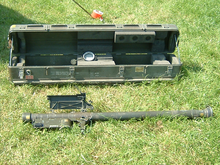Aviator fist
Fliegerfaust is now the Bundeswehr's name for a handgun to defend against aircraft. The term originally comes from the time of the Second World War . Towards the end of the war, the Wehrmacht tested the first models. The name goes back to the roughly similar bazooka in appearance and type of firing .
Models of the Wehrmacht
The Fliegerfaust-A was developed in 1944 by the HASAG company (H. Schneider AG, Leipzig) as a weapon against low-flying aircraft; the four 90-gram 2-centimeter rocket-propelled projectiles launched from a bundle of four tubes. The rocket projectiles reached a maximum speed of 380 m / s. Tests showed insufficient coverage of the hit circle and too great a spread. It was therefore decided to increase the number of pipes and their length.
The Fliegerfaust-B , also known as the Luftfaust , had nine pipes 1.5 meters in length. The nine shells (90 gram HE shells with a caliber of two centimeters, which carried 19 grams of explosives) were fired in two volleys with an interval of 0.2 seconds and formed a hit circle with a diameter of about 60 meters at a distance of 500 meters. The 6.5 kilogram weapon was simply placed with the rear part on the shoulder, there was no recoil. In March 1945 an order for 10,000 weapons with 4 million rounds of ammunition started . However, only 80 of these weapons were in the troop test at the end of April.
A six- barrel version with a larger caliber was supposedly being developed , which was simply to be called Fliegerfaust (without the suffix A or B).
armed forces
In the Bundeswehr two models have been called Fliegerfaust:
The Fliegerfaust 1 introduced in 1973 , a version of the US FIM-43 Redeye and, from 1992, the successor, the Fliegerfaust 2 Stinger , a version of the US FIM-92 Stinger .
Web links
Individual evidence
- ^ Fritz Hahn: Weapons and Secret Weapons of the German Army 1933-1945. Bernard & Graefe Verlag, Bonn 1998, ISBN 3-7637-5915-8 , pp. 208-209

